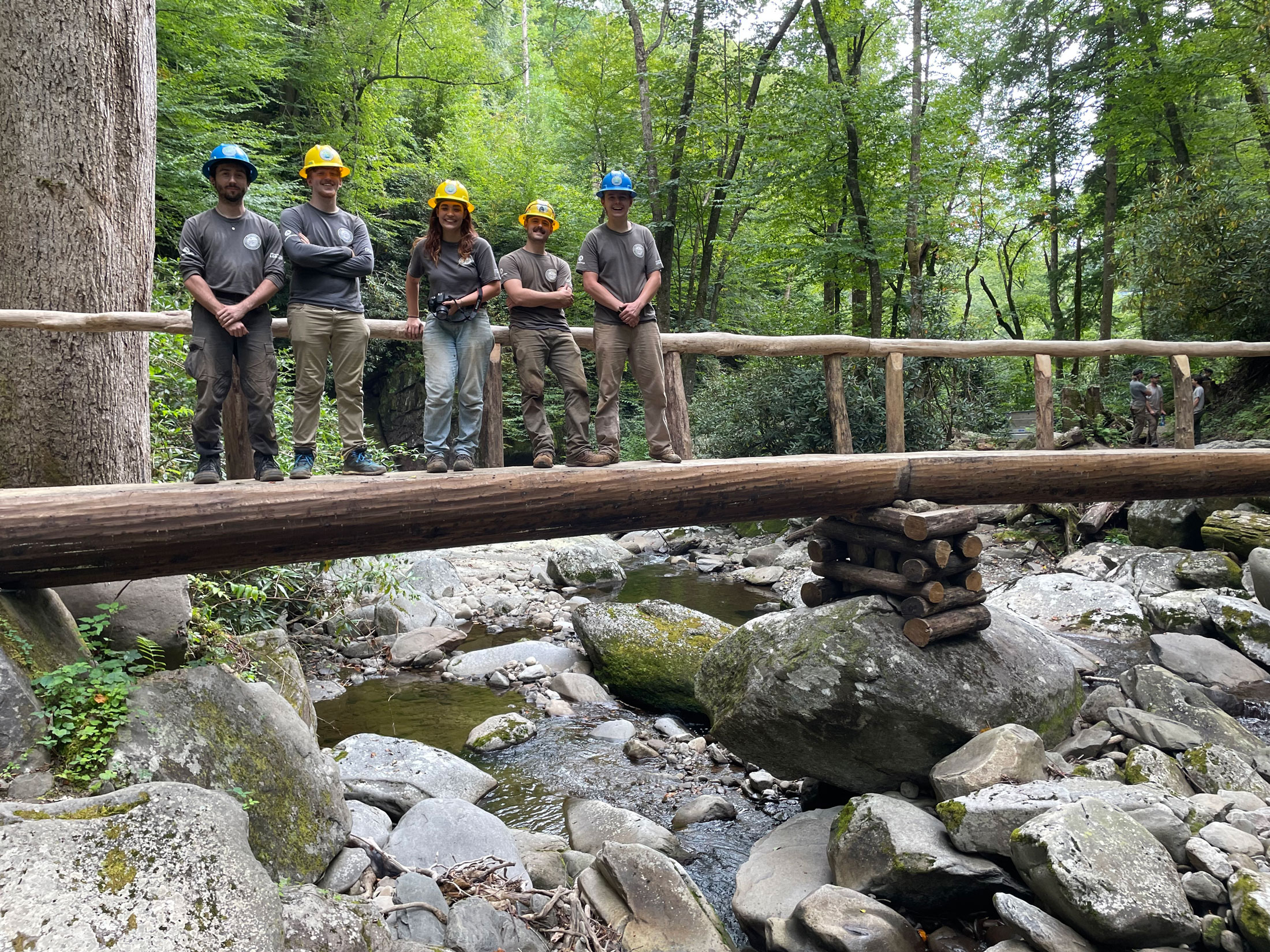
For the first time in nearly three years, the trail to Great Smoky Mountains National Park’s tallest waterfall is fully open—and following an intensive rehabilitation of its entire four-mile length, Ramsey Cascades Trail is in better shape than it’s been in decades.
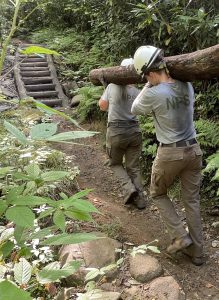
“It’s a great feeling, just seeing how hard everybody worked and how they overcame all of the challenges that came up that we weren’t planning for,” said Josh Shapiro, Trails Forever crew supervisor for the park. “Now that the trail’s safer and more navigable, I think more people will go up and be able to enjoy the waterfall.”
Ramsey Cascades tumbles down 105 feet of rock, creating a fitting reward for hikers hardy enough to complete the four-mile hike, which climbs more than 2,000 feet in elevation from the trailhead in the park’s Greenbrier Area. This picturesque promise makes Ramsey Cascades Trail one of the park’s most popular hikes. But all that traffic—coupled with heavy precipitation, erosion from nearby Ramsey Prong, and steep topography—had taken its toll on the trail.
“This trail had more deficiencies than most of the other trails we have worked on,” Shapiro said.
The Trails Forever crew that Shapiro oversees was created in 2008 through an endowment fund from Friends of the Smokies, the park’s philanthropic partner. The program supports a permanent trail crew capable of carrying out the skilled labor required to bring the park’s most degraded trails back to life.
Nearly 900 miles of trails crisscross the Smokies, most of them built during the Civilian Conservation Corps era in the 1930s and ’40s. The park has two full-time trail crews—one based in North Carolina and the other in Tennessee—that work to keep them clear of brush and blowdowns. But with such a large volume of trails to care for, those crews weren’t able to address the complex issues afflicting the park’s most popular trails. Trails Forever is filling that gap, with rehabilitations complete on Forney Ridge, Chimney Tops, Alum Cave, Rainbow Falls, Trillium Gap, and Abrams Falls trails—and now, on Ramsey Cascades. Friends of the Smokies has given nearly $4 million toward Trails Forever projects in the last 16 years, about a quarter of that for the Ramsey Cascades project.
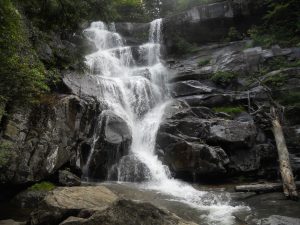
“It had been on the list for a long time as needing full-scale rehabilitation, because a simple replacement of a water bar was not going to be able to address the level of erosion challenges that the Ramsey Cascades Trail had,” said Dana Soehn, president and CEO of Friends of the Smokies.
The four-mile trail divides into two sections: the lower mile and a half, originally built as a road, and the upper two and a half miles, which travel through a steep mountain gorge. Both presented unique challenges. The lower section is three times as wide as a typical hiking trail and hardened with gravel. The crew had to recontour the path and dig new drains into the hardened surface, all without using heavy equipment. The upper section was rocky and heavily eroded, with the narrow gorge leaving little room for the trail crew to work. Rebuilding this section took “a lot of creativity,” Soehn said—and a lot of stairs.
Stairs are “the most sustainable solution” in a rugged, rainy area like upper Ramsey Cascades Trail, she said. But they are also an extremely labor-intensive solution. Trail crews build them using locust wood, a material that is naturally resistant to decay. But these logs are heavy—an eight-foot piece weighs about 100 pounds—and the area’s remoteness combined with the park’s guidelines for managing it as a proposed Wilderness Area mean that mechanized equipment can be used only in rare circumstances, and then only after acquiring special permission.
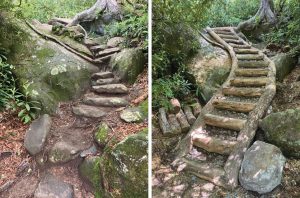
The park’s mule team usually moves heavy trail-building materials like locust logs, but a river crossing midway through the trail prevented the animals from accessing the upper section. In preparation for the project, the park obtained permission to have helicopters drop off more than 700 locust logs at five different locations on the upper two miles.
“Without the airlift, there’s no way we could have gotten the locust in there to rebuild some of the structures that were falling apart,” Shapiro said. But even with help from the helicopters, the crews sometimes had to carry these logs as far as a quarter mile away from the drop-off site.
On a typical day, 14 to 20 people were working on Ramsey Cascades Trail. In addition to the eight-person Trails Forever crew, American Conservation Experience and Southeast Conservation Corps crews were also on site, with the park’s two regular trail maintenance crews pitching in and volunteers helping out on Wednesdays.
Ramsey Cascades was originally scheduled as a two-year project starting in 2022. But major flooding two months in set that timeline back, severely damaging sections of the trail and leaving the area inaccessible by car. Within just a few hours on July 12, 2022, the Greenbrier area of the park received an estimated 8.72 inches of rain, after soils were already saturated from 5 inches of rain that had fallen the previous week.
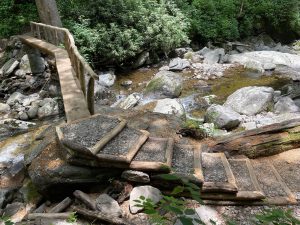
The area remained closed through April 2023, and the Trails Forever crew spent the remainder of the 2022 season assisting the Tennessee Trail Crew with its regular maintenance work, mostly in the Cosby Trails District. When they returned in 2023, their task list had expanded to include rerouting 900 feet of trail where the flood had washed it out and replacing two displaced footlogs that had previously been deemed solid enough to stay.
“It created a lot more work than we were planning for,” Shapiro said.
But the crews got it done, using 1,200 locust logs and 760,000 pounds of rock crush as they dug 151 drains, regraded 2.5 miles of trail, removed trip hazards, pruned overgrown vegetation, and built 2 bridges, decking and handrails on another bridge, and 600 steps. On Monday, November 18, Friends of the Smokies and the National Park Service held a ribbon cutting to celebrate reopening the newly rehabilitated trail.
This milestone arrived just two months before work is set to begin on another iconic waterfall hike—Laurel Falls Trail. This 1.3-mile trail, which receives 300,000 visits each year, will close for 18 months starting January 6, 2025. During this time, crews will widen and repave the trail, last paved in 1963; add 50 new parking spaces and a pathway to the trailhead protected from the main road by a guardrail; build a new viewing platform at the falls; and install new signs and educational panels. These changes aim to make the trail safer and more accessible to hikers while also better protecting the natural environment through which it travels.
“A lot of hikers are looking for a destination as part of their hiking experience, so having these trails open and accessible could give somebody their first opportunity to really experience the Smokies and all that hike has to offer,” Soehn said. “It’s very important for us to be able to sustain those trail experiences for users of today and tomorrow.”
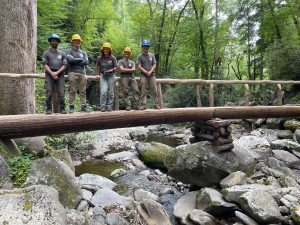
The Trails Forever crew will continue working toward that mission next year as it turns its attention to Bullhead Trail, the fourth of the five routes to Mount Le Conte to receive the Trails Forever treatment. Work will begin in May and is expected wrap up in November 2026. Parts of the seven-mile trail were severely damaged during the Chimney Tops 2 Fire in 2016, with significant erosion issues on the upper section. The crew will restore the entire length, making the trail safer and more sustainable for future hikers.
As Trails Forever enters its 17th year, Soehn is looking toward a horizon where all the trails in need of a top-to-bottom rehabilitation have received it, and rather than spending years working on one four-mile stretch, the Trails Forever crew can help keep trails throughout the park in tip-top shape.
“Over the years, we believe we’ll get to a spot where we will have addressed the need for full-scale trail rehabilitations,” Soehn said. “Then, the Trails Forever crew can address challenging maintenance needs on any trail section across the park. Because we want all trails—the full trail portfolio—to remain open and accessible to our visitors.”
Subscribe to get the latest posts sent to your email.
The Great Smokies Welcome Center is located on U.S. 321 in Townsend, TN, 2 miles from the west entrance to Great Smoky Mountains National Park. Visitors can get information about things to see and do in and around the national park and shop from a wide selection of books, gifts, and other Smokies merchandise. Daily, weekly, and annual parking tags for the national park are also available.